国际贸易专业双语教学论文3900字
- 格式:docx
- 大小:15.41 KB
- 文档页数:3
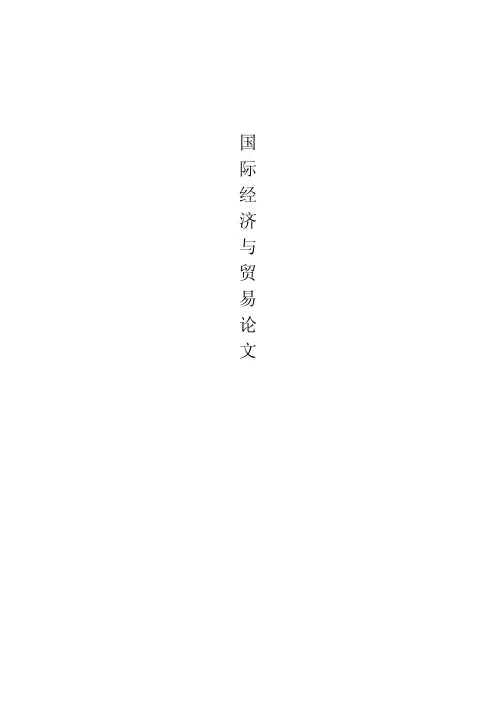
国 际 经 济 与 贸 易 论 文The contribution of foreign trade to China's economic growth analysis Summary: Although in recent years, China's exports continued strong growth,rapid expansion of trade surplus, rising position in international trade, import andexport commodity structure further optimize. But our economy still shows four uncoordinated: uncoordinated, uncoordinated merchandise trade and trade inservices, foreign trade of the eastern and western uncoordinated, uncoordinatedtrade and industrial s peed and efficiency. These uncoordinated has seriouslyaffected China's foreign trade growth in the quality and efficiency of foreign trade$ 2 trillion by 2020, by the number of goals, the traditional mode of growth isdifficult to achieve. This paper analyzes the status of China's trade from the start, to clarify the new situation adhere to quality realistic options strategies to improve the quality awareness of products and services, changes in competitive strategy of lowprices, and strive to build the core competitiveness of Chinese enterprises, China's manufacturing to China from the realization of create change.Keywords: international trade, our manufacturing, our creationFirst, the current development of China's foreign tradeChina's foreign trade has made remarkable achievements. China's current tradegrowth mode presents the following characteristics:(一)To expand the number of typeSince the reform and opening up, China's foreign trade developed rapidly, with anaverage annual growth over the same period the average annual growth rate in theworld of international t rade. Scale to promote the export of China's ranking inworld exports(二)the processing tradeAfter China's reform and opening up, the development of processing tradevery quickly, once reached more than 50 percent of China's total imports and exports, up 56.9 percent. In the 21st century, the processing trade has beengradually replaced by general trade, became the dominant position in China's foreign trade. And the concern is the rapid rise of China's processing trade and foreign direct investment behavior is closely related.(三)"three capital" enterprises have become the main exportSince the reform and opening up, China's foreign trade by guiding policy and industrial policy, foreign direct investment continues to grow. Foreigninvestment in China is mainly to fancy our huge market and low labor costs.Foreign-invested enterprises to adopt the great quantities of production,procurement of raw materials in foreign countries, domestic processing, production and export of products. Foreign exports accounted for more than 50% of the country's exports.(四) the export market structure is relatively simpleWith the development of economic globalization and regional economicintegration, China and neighboring countries and regions and regionaleconomic cooperation with other trade partners booming marketdiversification to achieve greater development. However, the proportion of the top ten trading partners of China's total imports and exports, total exports andtotal imports are still relatively l arge, top ten trading partners trade has accounted for more than 80% of China's total imports and exports, have declined until 2011 . The United States remained China's largest export market, Japan is still the largest source of imports.Second, the contribution of foreign trade to economic growth and the main problem of the existence of(一)Contribution of the Foreign Trade and Economic Growth1 imported factors of production can directly increase the supply of factors ofa country, for most countries, due to differences in resource endowments, the production can not completely have all the elements required for production, then the imports of production factors become a prerequisite for economic growth; for most developed countries, in the course of its economic take-off, without exception, have obtained through imports from less developed countries stable and cheap industrial raw materials, importing large quantities of these factors of production, on the one hand make up the lack of domestic supply of relevant elements, it also greatly increased the production of corporate profit margins, which is to maintain the level of domestic investment and thus promote economic growth played a significant role in promoting; for most developing countries, not only with the Like developed countries, the need to import some domestic scarce natural resources, and more importantly, developing countries generally lack the ability to produce modern machinery and equipment, advanced equipment imported by obtained from thedeveloped countries, its economic development played a crucial role.China's foreign trade in the process of rapid development, someenterprises lack of scientific management, the overall strength is weak; single means to participate in international competition; product non-pricecompetitiveness is not strong, the lack of its own brand and marketing network;low export levels, many products are still in the low end of the international division of the value chain links, the added value is not high. Extensive trade growth mode has not changed fundamentally, economic and social benefits tobe further improved.2 export development can be "driven" to increase domestic and foreign investmentFactor income of a country's export sector factor income is much higher than import-competing sectors. That is, the average profit margin of the export sector level higher than the average profit margin of import-competing sectors.Thus, it will have a substantial increase in domestic investment, "cause" part of the domestic export sector inflows factor in domestic factor mobilitymechanism is relatively smooth conditions, a large number of elements of theinflow means export sector. In addition to the increase driven by domesticinvestment outside the rapid development of the export sector will a ttractsome foreign investors to enter. As an important component of the foreigndemand for capital formation, which directly affects the formation of capital, which is directly related to the speed of economic growth. Coupled with the operation of foreign capital into the domestic counterpart funds, so active inthe entire national chain and become an incentive for economic growth.3 can be driven by the expansion of exports to increase domestic employmentForeign trade impact on a country's domestic employment levels, especiallyas our country such a large developing country with rich labor resources, the significance is undoubtedly a far-reaching and significant. American economist Anne. Kruger has made a study of this system. Professor Kruger that the choice of open trade strategy will also help job growth in developing countries. 30 years of reform and opening up, China's foreign trade to GDP growth rate higher than therate of rapid development, while the export commodity structure has also undergone major changes, from the export of primary products to manufacturedgoods into the main productive labor time intensive products industry has developed rapidly. Exports increased requirements to increase production, increase production and thus increasing employment needs. Professor Kruger believes compatible with different trading strategies trade policies will directly affect technology choice for all i ndustries, thus affecting the industrial c apital / labor ratio.4 Foreign trade can promote the formation of economies of scaleTraditional international t rade theory usually assumes constant returns to scale, that foreign trade does not exist economies of scale. In practice, however, the reality is assumed that the development of international trade is not consistent. U.S. economist Paul Krugman · R · believes that countries are increasingly similar, more imperfect market competition today, instead of the economies of scale factorendowments differences have become the main reason for the promotion of trade development. We know that many industry only reach a certain size in order to reduce costs, relying solely on the size of a small domestic market often can not be achieved. And one country to vigorously promote exports, expand the international market, the domestic industry can be formed that economies of scale to create the conditions.(二) At present the problems of China's foreign trade1. A low price competition caused by the gradual increase in anti-dumpinginvestigationAccording to China's Ministry of Commerce statistics, in June 2011, China's state-sponsored by other anti-dumping investigations has reached more than 600 since. In 2010 alone, China's anti-dumping investigation of 51 cases, involving 1.79 billion U.S. dollars, h as for 13 consecutive years as the world's anti-dumping investigations than any other country. Anti-dumping is for dumping purposes, theso-called dumping refers to the export price of a product at a price lower than the normal value of the market into another country. Dumping appeared, some countries are considered to be unfair trade practices and to be resisted by the legislative anti-dumping measures to protect the domestic industry. According to "Anti-Dumping Agreement," the implementation of anti-dumping measures musthave three basic elements: dumping, the causal link between the damage, dumpingand injury.Because our products generally have a clear price advantage, making international competitors and trading partners to take defensive or offensive trademeasures against Chinese products, and anti-dumping measures is most likely tobe used. Also according to "Anti-Dumping Agreement" provides for products fromnon-market economy countries, the normal price in determining the dumping, the importing countries generally use the price "alternative country" as the base price. Many trading partner of our products, as a non-market economy country, in determining the margin of dumping of the product is often deviated from WTOrules, select the price of other "alternative country" as determined in accordance with the normal price of the product. As the "alternative country" system flexibility so as to abuse of the importing country, "cut right amount ofand irrationality,freedom" in determining the dumping country when looking for an alternative toopen the door.2.Economies of scale and social imbalanceCurrently, there are 172 kinds of commodity production in the world, "China's manufacturing" has been in many countries around the world, penetrated intoevery corner of life, many countries consumers irresistible products. The scale of China's manufacturing expanded rapidly in the rapid increase in the share of world manufacturing the same time, there is a lot of regret: product exports nearly 30% share in total exports, the common feature of these products is the lowvalue-added, the price is very low , net of costs, the profit is very low, some products even price gains of only a few cents. U.S. exports equivalent to a Boeing airliner of 200 000 -30 million color TV sets exports.China's economic development is still stuck on to consume natural resources atthe expense of environmental quality development model. Rely on putting in a lotof natural resources and social resources in many areas has made the world'smarket share, but also caused a rather severe environmental problems. Environmental pollution and ecological destruction is increasingly becoming theimpact of global economic and social development issues, and to become the focusof people's attention.Third, adhere to the "quality win" strategyImprove the quality of trade growth quality and efficiency of export goods is a signof the national spirit, not only related to the efficiency o f enterprises, b ut alsorelated to the international image of our products. To better implement the "quality win" strategy, companies must the consumer's point of view, the product selectivityin durability, aesthetics, functionality, reliability, service, compliance, reputation and other aspects of comprehensive improve product and service quality, and increasethe added value of export products, and further optimize the export structure, tocreate its own brand of high-value and enhance the international competitivenessof export enterprises.(一)increase the export of non-price competitivenessProvided to meet the needs or desires of the target consumer products is the key to successful operation. Products are anything to offer to the market tomeet the needs and desires in the market include physical goods, services,experiences, events, people, places, property, organization, information andideas. Non-marketing guru Philip. Kotler believes Products include coreproduct, expected product, additional p roducts and potential interests, basicproducts five levels, e ach level adds more customer value, customer value hierarchy constituted. From the essence of today's product competitiveness isnot what companies in factory production, but other than that they increasethe plant in the form of other values, such as packaging, services, advertising, customer advice, financing, delivery arrangements and people seriously. Consumers generally from the factor characteristics and quality of products, product mix and quality of service, product prices and other judges he contacted products.1.Grasp customer price psychology, clever set commodity pricesAs the product information asymmetry, as well as non-professional consumers to buy, consumers in the purchase of goods, especially in the less familiar items to buy their own, always consciously or unconsciously, with the price and quality of goods intrinsic value linked to the price of goods as an important yardstick to measure the quality of the merits and value of size. They tend to believe that commodity prices are high, it means that the product is good quality, g reat value; low commodity prices, t hen the difference in the quality of goods, small value. Enterprises in the correct pricing strategy, t heprice must be in-depth study of the psychological impact on consumers, their prices grasp the psychological characteristics and can not take the low-price strategy.2 manufacturing customer perceived valueConventional wisdom is that as long as the price of the product is lower than competitors can seize more market . Reflect changes in the market price is the most sensitive factor for competitive products on the market position and market share has a direct impact . However, this effect is only limited in the industrial economy era , when corporate mission is to manufacture productsand sell products , but in the knowledge economy era , the task has become a manufacturing enterprise value and transfer value to the enterprise market competition into energy consumer competitive price competition rather thanthe value created by the product . The key goal of marketing is to correctly determine the customer's needs and desires , and more effective than competitors better target customers transferred the desired product or service , these products or services to meet consumer needs or solve the problems theyface tool. If the competition between enterprises blindly stuck in price competition stage , it will not only damage the interests of enterprises , and consumers are not necessarily derive a higher value because of price competition is necessarily accompanied by low-quality products and servicesand may also undermine the corporate image. With differentiated products ,high value-added services , such as core technical capabilities to compete , the benefits accruing to compete more generous than the low bleed . Companiescan earn huge profits , but also to compete for market share is more than the low significance. With the success of the enterprise should be a strength , corporate profits s hould be derived from the value of the market, but neveragainst opponents should be the purpose of business .Combined with the status quo of China's specific n ational conditionsand development of enterprises, the paper argues that treat green, technical barriers and trade friction from abroad, to calmly. On the one hand shouldchange their concepts, trade friction is clearly in the process of rapid economic development, a normal phenomenon, it i s difficult to avoid, and objectivelyrational measure friction, the impact of barriers to trade and the economy. On the other hand should take this as an opportunity to improve the capability of independent innovation, enhance scientific and technological content ofproducts. In addition, from the perspective of consumer psychology, low price competition for corporate branding strategy with hazards, Chinese enterprises should make full sense of urgency and mission, and strive to improve the value of the products, attention to technology investment, enhance productdevelopment and management, led export products.References:1.LiYushi.Changes in China's foreign trade2.LiJiaqin:On the Realization of Foreign Trade both a fundamental shift several issues3.YiShuoxiang:Changes in the competitive and comparative advantage ofthe growth mode4.JianXinghua:On China's foreign trade growth mode transformation5.LongGuoqiang:Foreign trade growth mode where to start6.ZhaoShuiqin:Reflections transformation of foreign trade growth mode 7.LiJunsheng:China's foreign trade and economic growth8.LiYuju:Accelerate the transformation of China's foreign trade growth 9.GuoKesha:The contribution of foreign trade to China's economic growth analysis10.XuJianbin: the current development of China's foreign trade。
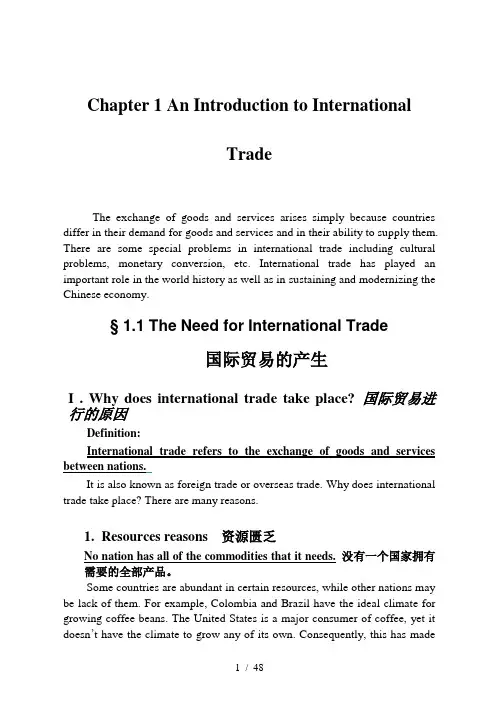
Chapter 1 An Introduction to InternationalTradeThe exchange of goods and services arises simply because countries differ in their demand for goods and services and in their ability to supply them. There are some special problems in international trade including cultural problems, monetary conversion, etc. International trade has played an important role in the world history as well as in sustaining and modernizing the Chinese economy.§ 1.1 The Need for International Trade国际贸易的产生I . Why does international trade take place? 国际贸易进行的原因Definition:International trade refers to the exchange of goods and services between nations.It is also known as foreign trade or overseas trade. Why does international trade take place? There are many reasons.1.Resources reasons 资源匮乏No nation has all of the commodities that it needs. 没有一个国家拥有需要的全部产品。
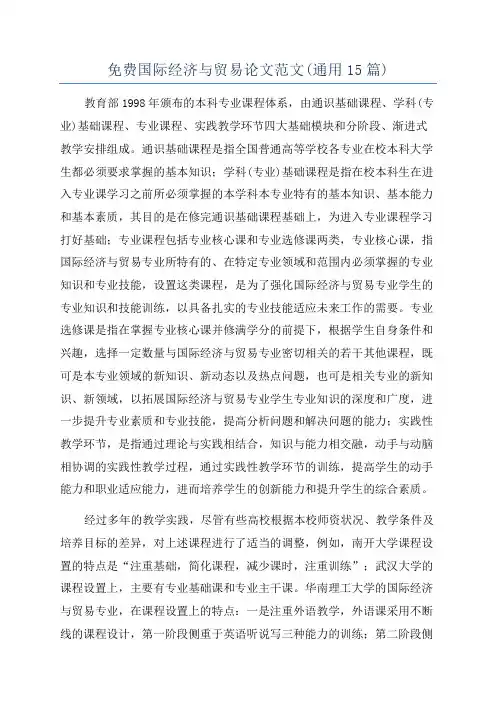
免费国际经济与贸易论文范文(通用15篇)教育部1998年颁布的本科专业课程体系,由通识基础课程、学科(专业)基础课程、专业课程、实践教学环节四大基础模块和分阶段、渐进式教学安排组成。
通识基础课程是指全国普通高等学校各专业在校本科大学生都必须要求掌握的基本知识;学科(专业)基础课程是指在校本科生在进入专业课学习之前所必须掌握的本学科本专业特有的基本知识、基本能力和基本素质,其目的是在修完通识基础课程基础上,为进入专业课程学习打好基础;专业课程包括专业核心课和专业选修课两类,专业核心课,指国际经济与贸易专业所特有的、在特定专业领域和范围内必须掌握的专业知识和专业技能,设置这类课程,是为了强化国际经济与贸易专业学生的专业知识和技能训练,以具备扎实的专业技能适应未来工作的需要。
专业选修课是指在掌握专业核心课并修满学分的前提下,根据学生自身条件和兴趣,选择一定数量与国际经济与贸易专业密切相关的若干其他课程,既可是本专业领域的新知识、新动态以及热点问题,也可是相关专业的新知识、新领域,以拓展国际经济与贸易专业学生专业知识的深度和广度,进一步提升专业素质和专业技能,提高分析问题和解决问题的能力;实践性教学环节,是指通过理论与实践相结合,知识与能力相交融,动手与动脑相协调的实践性教学过程,通过实践性教学环节的训练,提高学生的动手能力和职业适应能力,进而培养学生的创新能力和提升学生的综合素质。
经过多年的教学实践,尽管有些高校根据本校师资状况、教学条件及培养目标的差异,对上述课程进行了适当的调整,例如,南开大学课程设置的特点是“注重基础,简化课程,减少课时,注重训练”;武汉大学的课程设置上,主要有专业基础课和专业主干课。
华南理工大学的国际经济与贸易专业,在课程设置上的特点:一是注重外语教学,外语课采用不断线的课程设计,第一阶段侧重于英语听说写三种能力的训练;第二阶段侧重于国际商务英语的学习,以强化专业语言功能。
二是注重学生的社会实践能力的培养,将实习分为三个阶段:第一阶段为见习实习;第二阶段为外贸实习;第三阶段为毕业实习等,但主要课程设置上仍然大体相同,都没有对上述课程总体框架所规定的课程范围和内容做出实质性和突破。
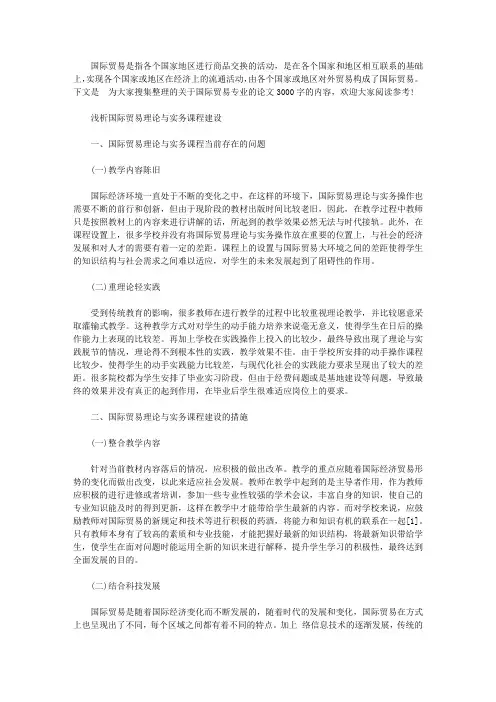
国际贸易是指各个国家地区进行商品交换的活动,是在各个国家和地区相互联系的基础上,实现各个国家或地区在经济上的流通活动,由各个国家或地区对外贸易构成了国际贸易。
下文是为大家搜集整理的关于国际贸易专业的论文3000字的内容,欢迎大家阅读参考!浅析国际贸易理论与实务课程建设一、国际贸易理论与实务课程当前存在的问题(一)教学内容陈旧国际经济环境一直处于不断的变化之中,在这样的环境下,国际贸易理论与实务操作也需要不断的前行和创新,但由于现阶段的教材出版时间比较老旧,因此,在教学过程中教师只是按照教材上的内容来进行讲解的话,所起到的教学效果必然无法与时代接轨。
此外,在课程设置上,很多学校并没有将国际贸易理论与实务操作放在重要的位置上,与社会的经济发展和对人才的需要有着一定的差距。
课程上的设置与国际贸易大环境之间的差距使得学生的知识结构与社会需求之间难以适应,对学生的未来发展起到了阻碍性的作用。
(二)重理论轻实践受到传统教育的影响,很多教师在进行教学的过程中比较重视理论教学,并比较愿意采取灌输式教学。
这种教学方式对对学生的动手能力培养来说毫无意义,使得学生在日后的操作能力上表现的比较差。
再加上学校在实践操作上投入的比较少,最终导致出现了理论与实践脱节的情况,理论得不到根本性的实践,教学效果不佳。
由于学校所安排的动手操作课程比较少,使得学生的动手实践能力比较差,与现代化社会的实践能力要求呈现出了较大的差距。
很多院校都为学生安排了毕业实习阶段,但由于经费问题或是基地建设等问题,导致最终的效果并没有真正的起到作用,在毕业后学生很难适应岗位上的要求。
二、国际贸易理论与实务课程建设的措施(一)整合教学内容针对当前教材内容落后的情况,应积极的做出改革。
教学的重点应随着国际经济贸易形势的变化而做出改变,以此来适应社会发展。
教师在教学中起到的是主导者作用,作为教师应积极的进行进修或者培训,参加一些专业性较强的学术会议,丰富自身的知识,使自己的专业知识能及时的得到更新,这样在教学中才能带给学生最新的内容。
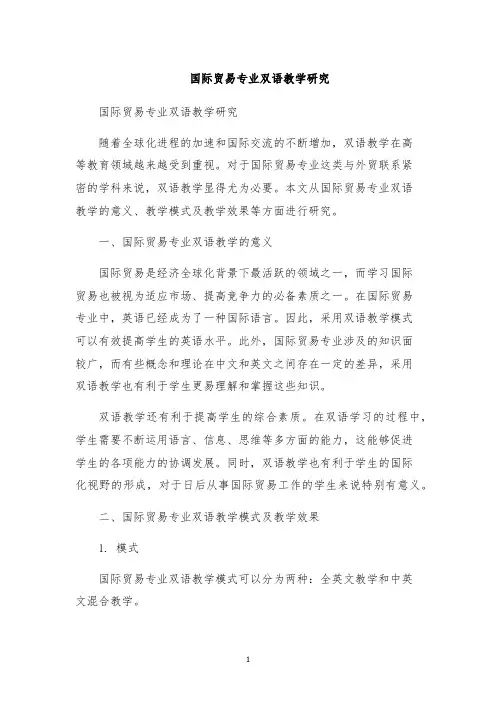
国际贸易专业双语教学研究国际贸易专业双语教学研究随着全球化进程的加速和国际交流的不断增加,双语教学在高等教育领域越来越受到重视。
对于国际贸易专业这类与外贸联系紧密的学科来说,双语教学显得尤为必要。
本文从国际贸易专业双语教学的意义、教学模式及教学效果等方面进行研究。
一、国际贸易专业双语教学的意义国际贸易是经济全球化背景下最活跃的领域之一,而学习国际贸易也被视为适应市场、提高竞争力的必备素质之一。
在国际贸易专业中,英语已经成为了一种国际语言。
因此,采用双语教学模式可以有效提高学生的英语水平。
此外,国际贸易专业涉及的知识面较广,而有些概念和理论在中文和英文之间存在一定的差异,采用双语教学也有利于学生更易理解和掌握这些知识。
双语教学还有利于提高学生的综合素质。
在双语学习的过程中,学生需要不断运用语言、信息、思维等多方面的能力,这能够促进学生的各项能力的协调发展。
同时,双语教学也有利于学生的国际化视野的形成,对于日后从事国际贸易工作的学生来说特别有意义。
二、国际贸易专业双语教学模式及教学效果1. 模式国际贸易专业双语教学模式可以分为两种:全英文教学和中英文混合教学。
全英文教学模式要求教师在授课过程中全部使用英语,学生需要直接用英语听、说、读、写等,适合英语水平较高的学生。
全英文教学模式可以提高学生的听说能力,但或多或少会对学生的理解和掌握程度造成一定的困难。
中英文混合教学模式是在中文和英文之间选择合适的文本进行教学。
这种教学模式既可以保证对学生的英语水平有一定要求,又可以保证学生能够更为深刻地理解和掌握所学的内容。
2. 效果双语教学对学生英语水平的提高和学术成果的提升有着显著的效果。
首先,双语教学可以提高学生的语言表达和翻译能力,为日后从事涉外工作打下较好的基础。
其次,双语教学可以让学生更好地理解和把握所学内容,特别是在国际贸易中涉及到的特殊用语和名词上。
此外,双语教学也有利于学生进行跨文化交流和认知,提高其国际化视野和能力。
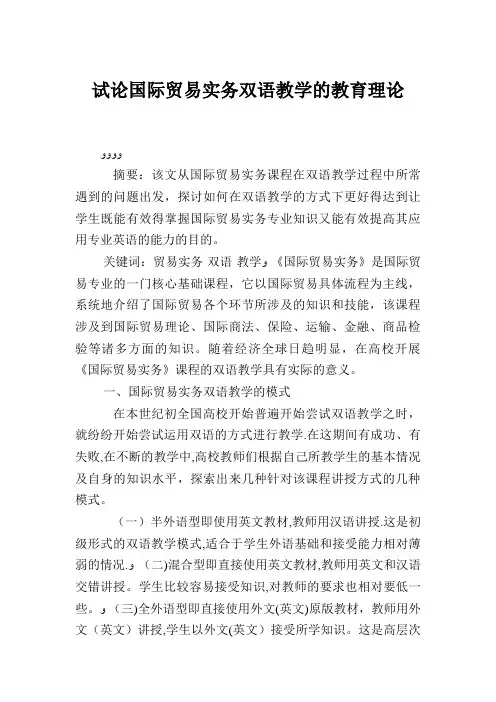
试论国际贸易实务双语教学的教育理论ﻭﻭﻭﻭ摘要:该文从国际贸易实务课程在双语教学过程中所常遇到的问题出发,探讨如何在双语教学的方式下更好得达到让学生既能有效得掌握国际贸易实务专业知识又能有效提高其应用专业英语的能力的目的。
关键词:贸易实务双语教学ﻭ《国际贸易实务》是国际贸易专业的一门核心基础课程,它以国际贸易具体流程为主线,系统地介绍了国际贸易各个环节所涉及的知识和技能,该课程涉及到国际贸易理论、国际商法、保险、运输、金融、商品检验等诸多方面的知识。
随着经济全球日趋明显,在高校开展《国际贸易实务》课程的双语教学具有实际的意义。
一、国际贸易实务双语教学的模式在本世纪初全国高校开始普遍开始尝试双语教学之时,就纷纷开始尝试运用双语的方式进行教学.在这期间有成功、有失败,在不断的教学中,高校教师们根据自己所教学生的基本情况及自身的知识水平,探索出来几种针对该课程讲授方式的几种模式。
(一)半外语型即使用英文教材,教师用汉语讲授.这是初级形式的双语教学模式,适合于学生外语基础和接受能力相对薄弱的情况.ﻭ(二)混合型即直接使用英文教材,教师用英文和汉语交错讲授。
学生比较容易接受知识,对教师的要求也相对要低一些。
ﻭ(三)全外语型即直接使用外文(英文)原版教材,教师用外文(英文)讲授,学生以外文(英文)接受所学知识。
这是高层次的双语教学模式,对教师和学生的外文水平要求较高。
值得注意的是,由于我国学生在普及教育阶段,外语的学习主要是以学生的读写能力为主,这直接造成我国高校在进行双语教学时多不能全外语型教学模式,而多停留在半外语型和混合型教学模式上。
二、国际贸易实务双语教学中存在的问题(一)教材选择的困难按照许多学校规定,国际贸易实务课程双语教材的选用标准为原版英文教材,也有相对宽松些的要求,使用的国际贸易实务双语教材。
就全英教材来讲,目前国内可使用的有两种途径。
一个是从外国引进的原版全英教材。
由于这些教材与的实际不相匹配,故很难采用。

国际贸易实务论文(6篇)摘要:在当前《国际贸易结算》课程的教学中仍存在着教学手段落后、理论脱离实践等问题,急需对教学方法进行。
在此基础上,结合实际教学过程的经验提出了案例教学法、实验教学法和双语教学法的实际运用,希望借此提升本课程的教学效果。
关键词:国际贸易结算;案例教学;实验教学法;双语教学法1、当前《国际贸易结算》课程教学中的问题分析1.1教学手段滞后对于《国际贸易结算》课程,传统的教学方法往往都是教师满堂灌,此法虽然在讲解中更系统、更完整,但会抹杀学生的积极性和主观能动性。
这种教学模式的主要表现就是课堂上学生只知道不停地记笔记,而不会去发现问题、提出问题,更谈不上进行创新了。
此种教学方法教师讲得很努力,但教学效果并不明显,学生只是一味地被动接受,对课程内容缺乏学习的兴趣。
此种教学模式下培养的学走上工作岗位后,解决实际问题的能力较差,在工作中极容易受挫。
1.2理论脱离实践在当前高校中承担《国际贸易结算》的老师很少有外贸企业的工作的经验,基本上都是从学校再回到学校,理论知识相对都很扎实。
但缺乏实践经验。
在教学中这些授课教师仅仅是凭借课本再借助互联网将知识传授给学生,这种脱离实际的教学模式很难满足学生们的需求,因为这些知识学生也很容易可以通过互联网获得,他们缺乏的是对一些实际操作的了解。
这种教学模式下,学生不能将学到的理论和实践有效结合,缺乏实践操作的能力,培养出来的学生也往往是“纸上谈兵”。
1.3教材不能随时更新伴随着经济全球化的迅速发展,与国际结算相关的国际惯例、进出口单据形式等也相应作出调整。
但由于教材出版滞后,教材内容与实际的操作会出现脱节,比如《UCP600》,《URDG758》等最新版惯例已生效,但很多高校使用的教材还没有及时更换。
而且比较好的双语教材也比较缺乏,更不利于高校推行《国际贸易结算》双语教学的进程。
2、《国际贸易结算》课程教学方法的2.1案例教学法案例教学法的特点是启发式、讨论式和互动式。
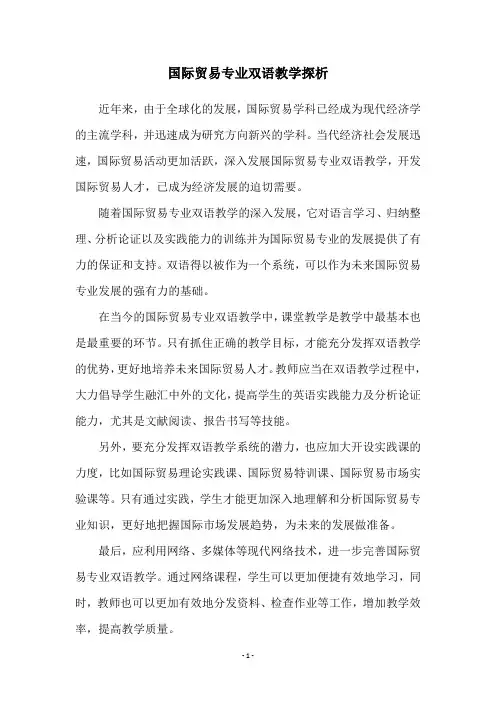
国际贸易专业双语教学探析
近年来,由于全球化的发展,国际贸易学科已经成为现代经济学的主流学科,并迅速成为研究方向新兴的学科。
当代经济社会发展迅速,国际贸易活动更加活跃,深入发展国际贸易专业双语教学,开发国际贸易人才,已成为经济发展的迫切需要。
随着国际贸易专业双语教学的深入发展,它对语言学习、归纳整理、分析论证以及实践能力的训练并为国际贸易专业的发展提供了有力的保证和支持。
双语得以被作为一个系统,可以作为未来国际贸易专业发展的强有力的基础。
在当今的国际贸易专业双语教学中,课堂教学是教学中最基本也是最重要的环节。
只有抓住正确的教学目标,才能充分发挥双语教学的优势,更好地培养未来国际贸易人才。
教师应当在双语教学过程中,大力倡导学生融汇中外的文化,提高学生的英语实践能力及分析论证能力,尤其是文献阅读、报告书写等技能。
另外,要充分发挥双语教学系统的潜力,也应加大开设实践课的力度,比如国际贸易理论实践课、国际贸易特训课、国际贸易市场实验课等。
只有通过实践,学生才能更加深入地理解和分析国际贸易专业知识,更好地把握国际市场发展趋势,为未来的发展做准备。
最后,应利用网络、多媒体等现代网络技术,进一步完善国际贸易专业双语教学。
通过网络课程,学生可以更加便捷有效地学习,同时,教师也可以更加有效地分发资料、检查作业等工作,增加教学效率,提高教学质量。
综上所述,国际贸易专业双语教学是现阶段朝夕相处的教学模式,它能够更好地培养未来国际贸易人才,促进国际贸易学科的发展,为经济发展做出贡献。
因此,当前应加强国际贸易专业双语教学的研究,完善双语教学的体系,研发更多有效的学习方法,以更好地发挥双语教学的作用。
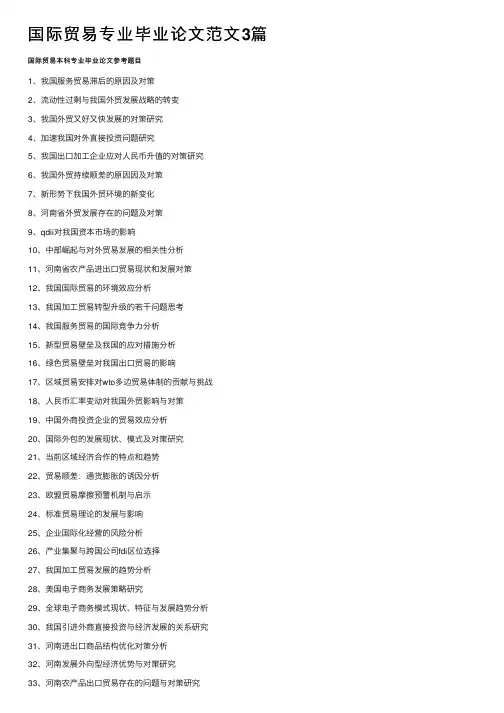
国际贸易专业毕业论⽂范⽂3篇国际贸易本科专业毕业论⽂参考题⽬1、我国服务贸易滞后的原因及对策2、流动性过剩与我国外贸发展战略的转变3、我国外贸⼜好⼜快发展的对策研究4、加速我国对外直接投资问题研究5、我国出⼝加⼯企业应对⼈民币升值的对策研究6、我国外贸持续顺差的原因因及对策7、新形势下我国外贸环境的新变化8、河南省外贸发展存在的问题及对策9、qdii对我国资本市场的影响10、中部崛起与对外贸易发展的相关性分析11、河南省农产品进出⼝贸易现状和发展对策12、我国国际贸易的环境效应分析13、我国加⼯贸易转型升级的若⼲问题思考14、我国服务贸易的国际竞争⼒分析15、新型贸易壁垒及我国的应对措施分析16、绿⾊贸易壁垒对我国出⼝贸易的影响17、区域贸易安排对wto多边贸易体制的贡献与挑战18、⼈民币汇率变动对我国外贸影响与对策19、中国外商投资企业的贸易效应分析20、国际外包的发展现状、模式及对策研究21、当前区域经济合作的特点和趋势22、贸易顺差:通货膨胀的诱因分析23、欧盟贸易摩擦预警机制与启⽰24、标准贸易理论的发展与影响25、企业国际化经营的风险分析26、产业集聚与跨国公司fdi区位选择27、我国加⼯贸易发展的趋势分析28、美国电⼦商务发展策略研究29、全球电⼦商务模式现状、特征与发展趋势分析30、我国引进外商直接投资与经济发展的关系研究31、河南进出⼝商品结构优化对策分析32、河南发展外向型经济优势与对策研究33、河南农产品出⼝贸易存在的问题与对策研究34、河南利⽤外资存在的问题及对策探讨35、河南对外投资存在的问题及对策分析36、河南进⼝贸易的发展前景分析37、外商直接投资对河南经济增长贡献的实证研究38、我国国际服务贸易国际竞争⼒提升对策研究39、试析我国引进外商直接投资中的技术外溢效应40、cepa对河南省外贸发展的影响41、外商直接投资与我国产业结构的优化42、中国出⼝贸易增长⽅式的转变所⾯临的机遇和困境43、中国企业“⾛出去”战略对我国产业升级的作⽤分析44、“10+3”框架下的中⽇韩经济合作问题研究45、东亚区域经济⼀体化的现状及前景46、对外贸易与产业集聚研究:来⾃中国的证据47、对外贸易与中国区域经济发展不平衡关系研究48、基于⽐较优势理论的河南省旅游服务贸易研究49、加⼯贸易对中国经济贡献的实证研究50、论fdi与中国区域经济的不平衡发展51、民营企业对外贸易的发展和影响分析52、试析对外贸易与中国产业升级的关系53、中⼩企业对外贸易⽅式探索54、中印外贸发展战略⽐较浅析55、河南省跨国企业发展现状与问题分析56、河南省出⼝农产品(⾷品)绿⾊营销问题分析57、中部地区对外贸易现状及问题分析58、我国对外贸易摩擦问题研究59、我国进⼝贸易依存度提升问题研究60、我国对外贸易协调机制构建问题研究61、国际技术贸易壁垒的新特点及对我国的影响62、西⽅对华出⼝贸易限制的新动向研究63、我国通货紧缩对出⼝贸易的影响64、我国贸易救济问题研究65、涉外经济对新农村建设的作⽤机制及路径研究66、我国企业跨国经营出现的新问题及对策67、中国农产品出⼝⽀持政策研究68、经济全球化条件下的新贸易保护主义研究69、国际直接投资与我国产业结构调整研究70、优化我国出⼝商品结构的途径71、劳⼯标准对国际贸易的影响72、中⼩企业国际营销策略分析73、国际营销发展的新趋势研究74、试析⼈民币汇率变动与国际营销定价关系75、我国企业国际营销存在问题及对策研究76、浅析中美经贸关系77、当前我国对外贸易⾯临的主要问题分析78、提⾼我国利⽤外资的质量、效益和⽔平79、对外开放战略与中部崛起80、试论我国产品国际竞争⼒的提升81、试论⽇本泡沫经济对我国的启⽰82、论最优货币区理论的现实意义和约束条件83、通货膨胀的国际传导机制及约束条件84、我国资本外逃的经济影响及对策分析85、国际货币体系的改⾰⽅向及其现实可⾏性86、论当代国际⾦融⼀体化的发展趋势和特点87、论战略产业保护理论的发展及其现实意义88、经济全球化的发展趋势及其对我国的影响89、论发展中国家区域经济⼀体化的约束条件90、论国际区域经济⼀体化的发展趋势和特点91、论中美贸易逆差的成因、影响及其对策92、论中美贸易摩擦的表现、成因及其对策93、论跨国公司转移作价的⽅法及其防范措施94、论跨国兼并与国际垄断的理论和现实问题95、论中国对外贸易发展模式的调整96、我国出⼝商品市场结构调整研究97、论我国科技兴贸战略的实施98、中国对外贸易增长的质量和效益分析99、国际环境保护的发展趋势及对我国的影响100、当代国际贸易理论的新发展及其现实影响国际贸易实务专业毕业论⽂写作中存在的问题与对策【摘要】毕业论⽂是⾼职教学计划的⼀个重要组成部分,是不可缺少的⼀个实践教学环节。

国际经济与贸易专业双语教学分析[摘要]本文研究基于地方高校国际经济与贸易专业双语课程开设对专业人才培养的重要作用,对目前双语课程教学中存在的问题进行分析,指出了目前存在着教学内容和学生能力脱节、师资力量不足、教学缺乏吸引力、实习落实不到位等问题,然后就如何提升双语教学的教学效果提出了可行的建议、建议分级教学、加强实践环节、丰富双语教学等手段。
[关键词]双语教学;教学手段;分级教学一、前言我国地方高校普遍开设国际经济与贸易专业,为我国经济发展培养外贸人才,作为地方应用型高校,在该专业的人才培养上注重在扎实的国际贸易理论基础上的外贸实操能力和商务英语沟通能力的培养。
基于这样的考虑,全国该专业普遍都开设了专业双语课程,采用双语教学。
双语教学是指使用中英两种语言开展教学,目前开设的双语课程主要集中在:国际贸易实务、国际经济学、国际结算,外贸函电等课程。
双语教学在国际经济与贸易专业的教学中承担着重要的作用。
是国际经济与贸易专业国际化人才培养的需要。
目前普遍采取的教学方式有两种,一是采用原版教材,全英授课,二是采用原版教材,中英文混合授课。
双语教学开展的目标是要学生在掌握专业的同时,掌握专业商务英语,使学生具备专业外文经贸材料的搜集整理分析和表达能力和外贸业务中的跨文化商务的交流能力。
树立学生的国际化视野和职业目标。
那么该如何组织好双语教学,使其在国际经济与贸易人才培养中发挥最好的作用呢。
二、目前地方高校国际经济与贸易专业双语教学存在的问题发挥双语教学的作用对国际经济与贸易专业的人才培养有着积极的促进作用。
但是目前地方高校,比如我国大部分的二本院校,在双语教学中都存在着一些问题,导致学生对双语课程的教学效果评价低于中文专业课程。
本文下面就目前存在的问题进行分析。
(一)教学脱离学生接受能力。
地方高校国际经济与贸易专业是一个非英语专业,学生的英语阅读能力和听力普遍无法到达流畅理解专业原版教材和课堂全英授课的水平。
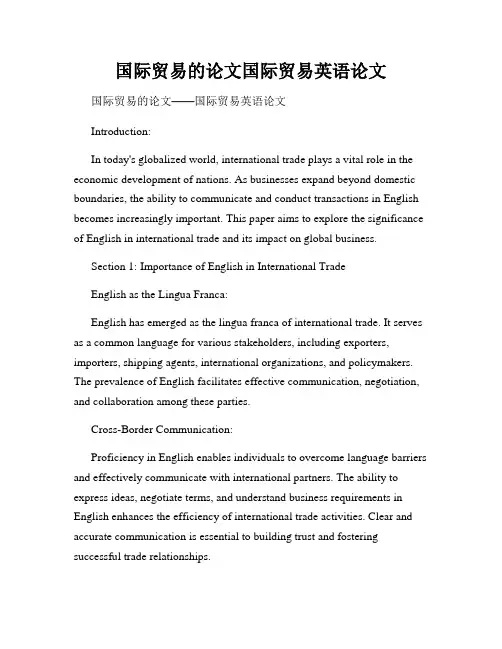
国际贸易的论文国际贸易英语论文国际贸易的论文——国际贸易英语论文Introduction:In today's globalized world, international trade plays a vital role in the economic development of nations. As businesses expand beyond domestic boundaries, the ability to communicate and conduct transactions in English becomes increasingly important. This paper aims to explore the significance of English in international trade and its impact on global business.Section 1: Importance of English in International TradeEnglish as the Lingua Franca:English has emerged as the lingua franca of international trade. It serves as a common language for various stakeholders, including exporters, importers, shipping agents, international organizations, and policymakers. The prevalence of English facilitates effective communication, negotiation, and collaboration among these parties.Cross-Border Communication:Proficiency in English enables individuals to overcome language barriers and effectively communicate with international partners. The ability to express ideas, negotiate terms, and understand business requirements in English enhances the efficiency of international trade activities. Clear and accurate communication is essential to building trust and fostering successful trade relationships.Access to Information and Resources:English is the primary language used in international trade literature, market research reports, and industry publications. A strong command of English provides individuals with access to a wealth of information and resources that are crucial for market analysis, identifying potential business opportunities, and staying updated with global trends. Without English proficiency, individuals may face difficulties in leveraging these resources.Section 2: English Skills Required for International TradeBusiness English:Proficiency in business English is essential for international trade professionals. This includes a strong grasp of business vocabulary, grammar, and usage. Business correspondence, such as emails, letters, and contracts, needs to be written clearly and accurately to avoid misinterpretation or misunderstandings. Additionally, the ability to give presentations, negotiate deals, and participate in meetings effectively requires a high level of English proficiency.Intercultural Communication:International trade involves working with individuals from diverse cultural backgrounds. Understanding cultural nuances and norms is crucial to building successful relations and avoiding potential conflicts. English proficiency enables individuals to navigate through cultural differences and promotes effective intercultural communication.Section 3: English Training and Development in International TradeEnglish Language Courses:To meet the growing demand for English proficiency in international trade, many educational institutions and language training centers offer specialized courses focusing on business English. These courses aim to enhance participants' language skills, develop industry-specific vocabulary, and improve presentation and negotiation skills.Corporate Training:Many companies invest in English language training programs for their employees engaged in international trade. These programs are designed to improve employees' English proficiency, enabling them to communicate effectively with international partners and clients. Tailored training programs address specific industry requirements and equip employees with the necessary language skills.Conclusion:English proficiency is a crucial factor in the success of international trade. It facilitates effective communication, enables access to information and resources, and promotes intercultural understanding. Proficiency in business English and intercultural communication skills are necessary for individuals engaged in international trade. To meet the increasing demand for English proficiency, specialized courses and corporate training programs are available to enhance language skills. As international trade continues to grow, the importance of English in this domain will only increase further.。
国际贸易的论文国际贸易英语论文在当今全球化的经济格局中,国际贸易扮演着至关重要的角色。
它不仅促进了各国之间的资源流通和经济增长,还推动了文化交流和技术创新。
而国际贸易英语作为国际贸易中不可或缺的沟通工具,其重要性也日益凸显。
国际贸易涵盖了众多领域和环节,包括货物贸易、服务贸易、技术贸易等。
在货物贸易中,从原材料的采购到成品的销售,涉及到的合同签订、运输安排、保险办理等都需要准确无误的交流。
服务贸易,如金融服务、咨询服务等,也依赖于有效的语言沟通来满足客户需求并确保交易顺利进行。
技术贸易则对专业术语和精准表达的要求更高,以保障技术的准确转移和应用。
国际贸易英语具有独特的特点。
首先,它具有很强的专业性。
涉及大量的贸易术语、行业惯例和法律条文等,如 FOB(离岸价)、CIF (到岸价)、L/C(信用证)等。
这些术语在国际贸易中具有特定的含义和用法,必须准确理解和运用,否则可能导致交易误解甚至失败。
其次,国际贸易英语的语言表达要求准确、严谨。
合同、函电等文件中的每一个条款和表述都需要清晰明确,避免模糊和歧义。
再者,由于国际贸易的参与者来自不同的国家和文化背景,因此国际贸易英语还需要具备一定的跨文化交际能力,要考虑到不同文化之间的差异,以避免因文化冲突而影响交易。
在国际贸易中,良好的英语沟通能力能够带来诸多优势。
一方面,它有助于拓展国际市场。
企业能够与更多的国际客户建立联系,了解他们的需求,提供符合市场需求的产品和服务,从而扩大市场份额。
另一方面,能够有效降低交易风险。
准确的语言交流可以避免因误解合同条款、运输安排等导致的经济损失。
此外,良好的国际贸易英语能力还能提升企业的国际形象,增强客户的信任和合作意愿。
然而,在实际的国际贸易交流中,人们往往会遇到各种语言障碍。
例如,由于英语不是母语,可能在语法、词汇和发音上存在错误,影响信息的准确传达。
不同国家的文化差异也可能导致对某些词汇和表达的理解偏差。
此外,行业知识的不足也可能导致无法准确理解和运用专业术语。
国际经济与贸易专业双语教学探索与实践【摘要】本文探讨了国际经济与贸易专业双语教学的实践和探索。
在介绍了背景和研究目的,以及双语教学的重要意义。
接着在正文中分别探讨了国际经济和贸易专业双语教学模式的探索情况和实施情况,教学方法和资源的整合,以及双语教学对学生的影响和应用。
结论部分总结了双语教学在国际经济与贸易专业中的价值,提出了未来发展方向,并作出结语。
通过本文的研究,可以更好地了解双语教学在国际经济与贸易专业中的重要性,为未来相关研究和教学实践提供参考和借鉴。
【关键词】国际经济与贸易专业、双语教学、探索、实践、教学方法、资源整合、学生影响、应用、价值、发展方向。
1. 引言1.1 背景介绍国际经济与贸易专业双语教学旨在培养学生具备国际视野和跨文化交流能力,适应全球化经济发展的需要。
随着经济全球化的加深和我国对外开放政策的推进,国际经济与贸易专业越来越受到重视,人才培养模式也面临着新的挑战和机遇。
传统的单一语言教学模式已经无法满足专业需求,双语教学成为一种必然趋势。
双语教学不仅可以提高学生的外语水平,还可以帮助他们更好地理解和应用专业知识,拓宽国际视野,提升国际竞争力。
在这样的背景下,国际经济与贸易专业双语教学探索与实践显得尤为重要。
通过对不同学校、不同课程的双语教学模式进行研究和比较,可以总结出最适合该专业的教学方式,为学生提供更加优质的教学资源和学习环境。
本文旨在探讨国际经济与贸易专业双语教学模式的具体实施情况,分析双语教学对学生的影响,探讨双语教学在该专业的应用前景,以期为该领域的教学改革和发展提供一定的参考和借鉴。
1.2 研究目的研究目的是为了探索国际经济与贸易专业双语教学的有效性和可行性,从而为提高教学质量和培养具有国际竞争力的人才提供借鉴和参考。
通过分析国际经济与贸易专业双语教学模式的实施情况,挖掘教学方法和资源的整合方式,研究双语教学对学生的影响,以及双语教学在国际经济与贸易专业中的应用现状,旨在深入了解双语教学在该专业领域中的作用和效果。
国际贸易论文优秀例文篇1浅析国际贸易专业教学创新经济全球化的不断深入和发展,各个学校都开始关注国际贸易专业的教学,使得国际贸易专业的教学得到了较快的发展,为对外贸易的发展培养了大批的人才。
但国际贸易对人才的要求在不断地提高,所以,我们要加强国际贸易专业教学创新的研究,以提高学生的专业素质和技能,培养更多的专业人才。
一、国际贸易专业教学问题分析(一)对实践教学关注不够国际贸易专业的教学目的是培养应用型的国际贸易专业人才,但是在传统的教学过程中,学校更多的是关注学历教育,忽视了实践教学。
偏重于理论教学,轻视实践教学;专业基础知识教育过多,应用性知识教育较少等在传统的专业教学中普遍存在。
导致学校在进行教学规划的时候对实践教学关注不够,规划的目的是学生理论知识的构建,不是实践能力的提高,所以使得学生的专业水平不能满足企业对人才的要求。
(二)理论教学和实践教学没有进行有效的结合我国大部分院校的国际贸易专业将理论教学作为课程设置的重点,而对实践教学却没有引起足够的重视。
理论知识教学中的许多内容是与实践相脱节的,教材中的内容在实际的国际贸易中并不一定实用,但是教材中却将之作为课程设置的重点,而一些在国际贸易中简单有用的实践知识却没有在教材中凸显出来,大大增加了学生适应国际贸易工作的难度。
(三)缺乏实用的双语教材国际贸易专业的教学是需要进行双语教学的,但是目前我国实用的双语教材却非常有限,而且质量不是很高。
所以很多学校在进行教学的时候就采用原版的教材,这些教材尽管具有较强的权威性与全面性,但是却与本校的课程设置和我国的课程设置要求不符。
此外,外国人的思维方式和经济背景都与我国存在巨大的差异,导致学生难以接受。
还有原版教材的引进成本较高,增加了学生的负担。
(四)落后的教学方法不利于人才的培养人才的培养需要好的教学方法做支撑,如果缺乏有效的教学方法,教师只是按照传统的教学方法来教学,那么教学效率和质量都将没有保证。
国际贸易实务论⽂国际贸易实务是经济学的主⼲课程之⼀。
随着中国社会主义市场经济的完善与发展,中国的涉外经济与贸易活动更加活跃,只有掌握了国际贸易的实务知识,才能在进出⼝业务活动中,正确贯彻中国对外贸易的⽅针政策和经营意图,确保最佳经济效益,并且能按国际规范办事,使我们的基本做法能为国际社会普遍接受。
随着中国外贸经营权的进⼀步开放,中国对外贸⼈才的需求量是很⼤的,学好国际贸易理论和实务课程是当务之急。
国际贸易实务论⽂1 ⼀、课堂教学改⾰,提⾼和加强教学过程的实践性 1.教学改⾰效果机制。
教学效果评价采取课堂学习与实践能⼒的结合。
在考核中还应加上外贸实验、单证模拟训练、等⽅⾯的考核成绩。
通过合理的学习成绩考核系统,使学⽣不但注重学习的结果,⽽且注意学习的过程,使学得的知识扎扎实实,实践动⼿能⼒也得到了培养。
2.校企互动,请专家⾛进课堂。
学校应根据所设专业的特点,采⽤各种⽅式邀请有⼯作经验的外贸企业领导或管理⼈员来校作报告或讲课,向学⽣介绍企业发展的状况,介绍外贸企业在市场竞争中发展的经验,,解答学⽣在国际贸易实务学习过程中遇到的⼀些理论和实践问题等,使学⽣在步⼊社会之前,更好地了解社会,从⽽进⼀步提⾼学习兴趣。
3.改⾰教材内容、创新教材。
长期以来,国际贸易专业教材⽼旧,不能跟上时代和⾏业的发展。
不利于学⽣实践能⼒的提⾼和职业能⼒的养成。
鉴于这种情况,就要求国贸专业教学的⼀线教师为主体,以⾏业为导向,以实际操作为核⼼开发校本教材。
教材的内容还应该注意培养学⽣的综合职业能⼒。
另外,校本教材要有针对性和实⽤性的内容。
作为⼀名从事《国际贸易实务》课程教学的教师,要结合学⽣⾃⾝特点,在教学过程中,不断转变传统的教学观念和教学改⾰,⼤胆尝试和探索新的教学⽅法,争取为社会培养出更多的适应对外贸易发展的优秀⼈才。
⼆、加强实验室建设,加强模拟实习环境 1.建⽴国际贸易电⼦实验室。
如在“汇票的使⽤”学习中,可组织学⽣模拟外贸票据使⽤的场景,学⽣分别饰演出票⼈、受票⼈和收款⼈等⾓⾊,模拟汇票的出票、提⽰、承兑、背书、付款或拒付、追索的具体票据⾏为,这样使学⽣在表演才能的同时,对汇票的使⽤流转过程有了更全⾯、深刻的理解。
国际贸易专业双语教学论文3900字
一、国际贸易专业开展双语教学的必要性
1.推动“双语教学”是国际贸易专业适应我国教育教学改革的大环境的需要
2001年教育部颁发的《关于加强高等学校本科教学工作提高教学质量的意见》(教高字
[2001]4号)中就提出,“本科教育要创造条件使用英语等外语进行公共课和专业课教学。对
高新技术领域的生物技术、信息技术等专业,以及为适应我国加入WTO后需要的金融、贸
易、法律等专业,更要先行一步,力争3年内,外语教学课程达到所开课程的5%-10%。”2005
年1月,教育部在《关于进一步加强高等学校本科教学工作的若干意见》(教高[2005]1号)
文件中再一次明确提出“要提高双语教学课程的质量,继续扩大双语教学课程的数量”的要求。
2.国际贸易专业课推行双语教学是适应WTO的要求的需要
随着世界经济的一体化进程的加快与世界文化的融合,要求通过提高高校国际贸易学的
双语教学,培养既有丰富专业知识,熟悉中国国情,又有较好外语水平,精通WTO规则和
世界经济的国际化的人才。从这个意义上讲,国际贸易专业课双语教学势在必行。在国际贸
易学专业推行“双语教学”的目的不在于推进专业英文教学,其真正目的在于培养学生——未
来的商务人士、创业者,应用外语在工作中交流,或应用外语在专业上学习,更新知识,自
我提高能够具备同合作伙伴、国际竞争对手沟通和对抗的能力,真正成为“面向国际市场竞
争、具备国际经营头脑”的国际商务参与者和管理者。上述人才培养目标的实现,离不开与
国际先进教学模式的接轨,离不开对西方先进管理思想与方法的研究和借鉴,更离不开英语
这一国际贸易通用语言的运用和英语思维能力的培养。
二、国际贸易实务开展双语教学的主要模式
国际贸易实务的教学内容具有国际性,其教学目标具有外向性的特点。国际贸易实务教
学目标的涉外性和教学内容的国际性,决定了该课程进行双语教学的必要性。同时,国际贸
易实务双语教学不仅是贸易全球化发展趋势的必然要求,而且也是培养国际性、复合型经济
人才的需要。具体而言,在实践中,开展国际贸易实务存在三种模式。
1.简单渗透型
在国际贸易教学中以中文授课为主,用英语讲授一些国际贸易术语,并穿插使用一些常
规的课堂用语,学生的考试采用中文形式。这种模式对教师的英语水平要求不高,适合英语
基础和接受能力相对薄弱的学生。从教学效果上看,学生容易形成系统的以中文为媒介的知
识体系,而英文掌握的只是零散的一些专业词汇。双语教学的最高目标是在专业文献的使用
上、专业实务具体操作上能够做到双语自由转换。这种双语教学模式由于中英两种语言的比
重十分不平衡,教学过程中英文信息量不足,所培养的学生就其专业的英文知识而言十分有
限,很难达到双语教学的真正目标要求。这显然是简单渗透型的双语教学模式的不足之处。
2.过渡型(混合型)
在双语教学中以英语为主,采用英语板书和原版教材,在英语授课的同时辅以中文解释
和说明,学生的作业、考试用英语出题,但用中文回答。这是目前我国国际贸易双语教学中
采用最多的一种模式,穿插过渡型双语教学模式的优点在于双语的比重趋向均衡,采用这种
教学模式与上种模式相比,教学过程中的英语信息量有了明显增加,但是对教师和学生要求
相对提高了,特别是学生必须具备较高的英文水平,否则很难感知英文教材,更难听懂英文
讲授。
3.浸入型(全英语型)
在双语教学中基本上使用英语,采用原版专业教材,课堂板书用英文,学生的作业、考
试用英文出题,学生答题一般用英语。这种模式的特点是对教师和学生的外文水平都有较高
的要求。
以上三种方式各有所长。浸没式双语教学让学生有一个很好的语言环境,因此教学效果
较好,但是对老师和学生的要求都比较高,尤其是语言环境的创造有诸多困难。过渡式双语
教学将第二语言逐步引入教学全过程维持式双语教学则是将第二语言作为教学语言的同时,
继续用母语来维持学生理解的一种的教学模式,这两种模式比较适合双语教学的起始阶段,
但母语与非母语的比重难以把握。在我们的教学实践中,主要采用以英语浸没式教学法为主,
辅以参与法的教学模式。
三、国际贸易专业双语教学的目标体系
双语教学的目标体系是国际贸易专业教学目标的重要组成部分,它包括双语教学的课程
体系、双语教学的能力体系两大部分。双语教学的课程体系包括国贸专业知识、国贸专业英
语素养两部分。双语教学的能力体系包括英语应用能力和社会适应能力两部分。
1.国际贸易专业双语教学的总目标
通过双语教学,不仅要求学生掌握专业知识和英语技能,更要重视学生对专业知识与英
语技能的应用。通过本专业的学习,学生将提高专业知识水平,加深对国际贸易业务的理解;
学会运用外语技能,增强学生外贸业务的实践能力和创新能力;增强学生人际交往技能和团
队意识;树立学生的自信心,激发学生的潜能,增强其就业竞争能力。
2.国际贸易专业双语教学课程目标
双语教学课程目标是双语教学目标体系的重要组成部分,包括国贸专业知识、国贸专业
英语素养两大部分,它涵盖了国际贸易专业学生必修的全部专业知识课程。在双语教学安排
上从两大块来完成这两部分的教学任务,一部分国贸专业知识的中文讲授包含了五大主干课
程,另一部分国贸专业英语素养的双语讲授包含了四大主干课程。
双语教学课程的目标分类方法有利于教师实施课程标准,使整个课程目标落到实处。双
语教学的实施是在国贸专业知识掌握的基础上来开展的,学生在学习相关专业知识的基础上
进行国贸实务的双语学习,将有助于学生的理解,减少许多国贸专业词汇带来的学习障碍。
双语教学课程体系目标两大部分是互相联系的整体,每个部分各有侧重。国贸专业知识
目标要求学生熟练掌握贸易理论、专业国贸知识和贸易惯例,培养学生全球贸易观念,掌握
基本的国际贸易技能和方法。
3.国际贸易专业双语教学能力目标
双语教学能力体系目标主要指学生通过双语的学习所获得的用英语处理国贸实务的技
能,它包括英语应用能力和社会适应能力两大部分。实现双语教学能力体系目标,一方面可
通过校内实验室模拟国贸实务操作环境的测评、模拟国贸场景交易的测评、单证制作及审核
测试、函电写作测试等来反映学生双语学习所获得的能力水平;另一方面也可通过校外的实
训实习基地参与国贸实际业务各环节的实践来测评学生的社会适应能力。
四、国际贸易专业课堂双语教学的探讨
1.在教学组织中贯彻教育目标
涉外经济活动人才经常从事国际经济业务,有更多的时间和机会接触英语国家的思想观
念,行为方式等。我门常常把培养国际性人才作为国际贸易专业人才培养的高境界,这是因
为我们深知,在经济全球化日益形成的今天,以开放的心态面向世界的重要性。因此,在双
语课教学中,我们应该首先树立学生“民族性最鲜明的,也最富有国际性”的观念,把我们国
家处理国际经济、外交关系的基本原则贯穿于教学中,讲清楚社会、经济、文化进步中的开
放与保持民族意识,民族认同感,民族自尊、自豪的关系,使我们的专业教育目标通过教学
实现。
2.正确设立课堂教学目标,以专业知识为主线组织英文书面信息呈现,以母语为主,阐
释复杂深奥观点
我们知道,课堂教学是实现课程教育教学目标的一个环节。专业课的双语教学不同于大
学英语等公共英语课教学,语言只是工具。依据课程教学大纲,每一次课堂教学时间内,基
本教学目标是掌握系统的专业知识,而不是形成英语的听说读写译等语言能力。为此,宜采
用英文呈现有关专业知识的书面信息。
3.注意调动学生的积极性,破除学生害怕出错、不敢自由表达的畏惧心理,树立学生表
达思想的信心
在第二语言不熟练,或者没有经常性使用时,每要表达一定意思,总会出现先出考虑语
法对不对的现象,这样反而妨碍了思想的表达。为此,课堂上要鼓励学生大胆开口,不怕出
错,凡不涉及基本概念,基本理论思想被曲解,就不纠正学生,尽量避免使用试错、负强化
等教学手段,而是通过正强化,总结等方式来传达正确信息。
4.严格使用学习评估方法
兰伯特(Lambert)的态度/动机模式(attitude/motivationmodel)认为,在双语学习方面,性
向和态度是两个重要的、相对独立的影响因素;双语学习不仅需要某种认知能力,而且需要
一种积极的态度;态度关系到动机。因此,双语能力基于性向、态度、动机的程度以及态度
与动机之间的关系。依据这种理论,双语教学应该采用英文试题进行考试,这样不仅能够使
学生明确学习要求的严肃性,而且可以利用学生重视考试的心理,强化课堂学习的直接动机。
课堂教学组织技巧是教师使有组织的教育形式在明确的教学目标,有重点的内容组织,
系统并赋予连贯性的师生互动下收到实际效果的主要途径,也是教师“教育艺术”的展示平台,
各个教师可能有自己的独特做法和经验,但是,从整体上把握专业培养目标,把其作为处理
教学中语言能力形成与系统专业知识讲述的大原则,有助于组织起知识传授与技能形成相融
合的课堂教学环境。
参考文献:
[1]姜瑾:双语教学面面观[J].天津外国语学院学报,2003,(1).
[2]王振宇邓弘:国际贸易主干课程双语教学的思考[J].江西教育科研,2004.(3).
[3]罗郑胜:国际经济与贸易专业(本科)培养目标及知识、能力、素质结构分析.郑州经
济管理干部学院学报,2005(12).
[4]石碧涛:双语教学实验环节探索———以《国际贸易实务》为例[J].高教探索,2007(6).
[5]马小辉:国际贸易专业双语教学实践及问题研究[J].黑龙江教育,2007,(4).
[6]陈燕:国际贸易专业课推行双语教学的SWOT分析[J].甘肃联合大学学报(社会科学
版).2008,(5).